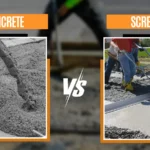The United Kingdom, renowned for its temperate climate and often characterised by its mild, damp weather, has experienced a notable shift in recent years. Global climate change is influencing weather patterns worldwide. Concrete pouring in hot weather presents significant challenges that construction professionals must understand and prepare for. Above all, these heat waves can have significant implications for various sectors, including construction.
To ensure the successful execution of projects in such extreme environments, construction professionals must carefully navigate the intricacies of concreting in hot weather.
The Impact of Heat on Concrete Quality and Strength
As the concrete undergoes the process of cement hydration, it goes through a crucial phase of strengthening. This process involves the bonding of water with the concrete mixture, forming crystals within the concrete. To have optimal durability, proper curing concrete in hot weather techniques are essential. It may span several weeks or longer. Also, some major issues can arise during hot weather concreting:
- The high temperature causes rapid water evaporation from the concrete surface, leading to drying out. Further, this can result in weaker concrete, making it susceptible to cracks, chips, and other structural problems.
- Warm conditions can accelerate the drying process, which possibly causes the concrete to become weak or soft. Does concrete dry faster in hot weather? Yes, and this rapid drying can compromise the final strength of the concrete due to insufficient moisture during hydration.
- The increased heat may adversely affect the concrete’s performance during the critical initial curing period.
- Also, concreting in severe weather may reduce 28-day strength by up to 10% compared to optimal conditions.
How to Minimise the Effect of Hot Weather?
By adequately scheduling and implementing effective strategies, it is possible to pour concrete at a higher temperature without compromising its quality. To control the concrete’s temperature in such conditions, the following tips can be employed:
- Specialised Mix Design: Opt for a concrete mix designed for hot weather applications to enhance its performance and resilience.
- Temperature-Controlled Mixing: Make necessary adjustments to the mixture and utilise chilled mixing water to regulate the temperature during the mixing process.
- Surface Preparation: Further, dampen the substrate before placing the concrete to prevent excessive water evaporation from the mixture.
- Chemical Additives: Incorporate a retarding admixture to slow down the setting time of the concrete, allowing sufficient time for proper placement and finishing.
- Strategic Timing: Schedule the concrete pouring in hot weather early in the morning or late in the afternoon when the ambient temperatures are lower. Further, it minimises the risk of rapid evaporation.
- Environmental Controls: Settle sunshades around the concrete area to shield it from direct rays and maintain a cooler environment for better curing.
- Workforce Planning: If feasible, increase the number of workers involved in the process to expedite the finishing and confirm that the concrete is worked with promptly.
How to Keep My Concrete Mix Cool During Hot Weather?
Keeping your concrete mix cool during hot weather is essential for achieving optimal strength and durability. Here are effective strategies that professionals use to manage concrete temperature during hot conditions.
1. Water Temperature Management
The simplest way to control concrete temperature begins with your mixing water. Start by using cold water when preparing your concrete mix. The cooler the initial water temperature, the longer it will take for the concrete to heat up during hydration.
For more extreme conditions, consider these additional techniques:
- Replace a portion of the mixing water with ice or chilled water
- Store water in shaded areas or refrigerated containers before mixing
- Aim for a water temperature between 45°F (7°C) and 65°F (18°C)
2. Site Preparation and Environmental Controls
Creating a favorable environment for your concrete pour can significantly impact the success of your project during hot weather.
Before placing concrete, thoroughly wet the subgrade or formwork to create a cooler environment and prevent rapid moisture absorption from the mix. This simple step helps maintain the concrete’s workability for longer periods.
Controlling the environment around your concrete can make a substantial difference:
- Erect temporary shade structures over the pour site
- Install windbreaks to minimise hot, dry winds that accelerate evaporation
- Use shading nets over freshly laid surfaces to lower surface temperatures
- Schedule concrete pouring in hot weather for early morning or evening when temperatures are cooler
3. Chemical Admixtures and Special Mix Designs
Modern concrete technology offers several solutions specifically designed for hot weather applications:
Incorporate chemical retarders into your concrete mix to slow down the setting time, allowing for extended placement and finishing periods. These admixtures are particularly beneficial when working in extreme heat conditions.
Hydration control admixtures can regulate the hydration process, reducing the heat generated during curing. This helps prevent thermal cracking and improves the final strength of the concrete structure.
How to Stop Concrete Cracking in Hot Weather?
Preventing cracks in hot weather requires a strategic approach to both materials and methods. These proven techniques will help ensure your concrete maintains its integrity even during extreme temperature conditions:
-
Optimise Concrete Mix Design:
Develop a concrete mix with a well-balanced cement, aggregates, and water composition. The appropriate mix presents maximum strength, which contributes to crack resistance.
-
Control Water Content:
Minimise the water-to-cement ratio in the mix, as excess water weakens the concrete and intensifies cracking vulnerability. Also, utilise superplasticizers and water-retaining admixtures to retain moisture for an extended period during curing.
-
Incorporate Supplementary Cementitious Materials (SCMs):
You can enhance the concrete’s properties by including SCMs like fly ash, silica fume, or slag. These materials decline heat generation during hydration, making the concrete more resistant to thermal cracking.
-
Low-Heat Cement:
Consider using low-heat cement, which renders less heat during curing, lowering the risk of temperature-related cracking.
-
Efficient Curing Methods:
Follow proper curing techniques such as wet burlap, polyethylene sheets, or curing compounds. It helps preserve adequate moisture levels and protect the surface from rapid drying.
-
Temperature Monitoring and Control:
Everyone must install temperature sensors to monitor the concrete’s temperature during curing. Implement cooling methods, such as water or ice application, if the temperature becomes excessively high.
-
Strategic Control Joint Placement:
Make use of control joints at regular intervals to allow for controlled cracking at predetermined locations. Also, adequate spacing and depth of control joints should be based on the concrete thickness and expected shrinkage.
-
Proper Site Preparation:
Ensure the construction site is sufficiently prepared, with appropriate subgrade preparation and protection from extreme heat.
-
Expert Concrete Placement:
Employ experienced concrete placement crews who understand the challenges of working in hot weather and can precisely execute the job.
Conclusion
As you gain experience and knowledge, your expertise in concreting in hot weather will undoubtedly grow. Remember, every project is a learning opportunity, and your dedication to mastering this skill will set you apart as a professional in the construction industry.
From residential driveways to commercial foundations, Pro Mix Concrete delivers the perfect balance of quality, service, and value. Our team of concrete specialists provides on-call assistance and site consultations to ensure optimal results for your specific project
Contact us today to request a Free quote!
Frequently Asked Questions
High temperatures can cause rapid water evaporation, leading to weak concrete, increased cracking, and reduced durability.
Use a balanced mix, control water content, apply curing methods, and place control joints to manage shrinkage and temperature changes.
Yes, high temperatures accelerate water evaporation, causing concrete to set quickly, which can weaken its final strength.
Early morning or late afternoon when temperatures are lower, reducing evaporation and improving curing conditions.
Yes, retarders slow setting time, and hydration control admixtures regulate curing to prevent strength loss.
Author
- Dennis Broderick
- Dennis Broderick is the founder and owner of Pro-Mix Concrete Company, a trusted name in ready-mix concrete solutions across the UK. With over 20 years of hands-on experience in the construction and concrete industry, Dennis brings unmatched expertise, practical insights, and a commitment to quality on every project - from residential driveways to large-scale commercial developments.
Latest entries
BlogJuly 15, 2025Why Same-Day Concrete Delivery is Vital for Small Builders in London?
BlogJuly 10, 2025Concrete vs. Screed: Which is Best for Your Project?
BlogJuly 5, 20255 Mistakes to Avoid When Ordering Ready Mix Concrete in London
BlogJune 27, 2025How Same-Day Concrete Delivery Works in the UK?




